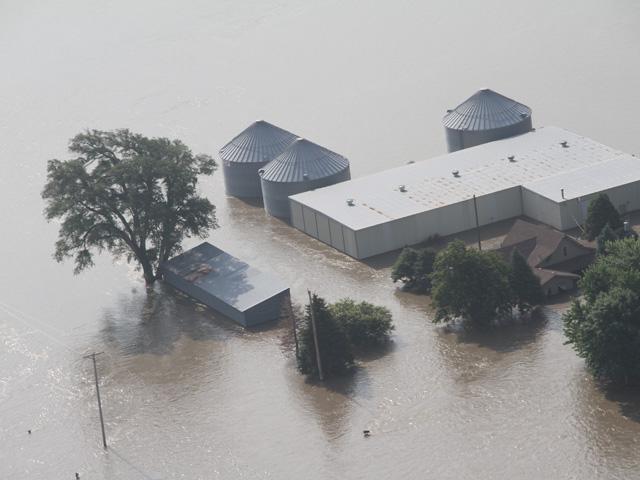Missouri River Farmers Win in Federal Court
Court: Farmers Should Be Paid For Crops, Property Lost in Missouri River Floods
LINCOLN, Neb. (DTN) -- Some farmers along the Missouri River could be compensated for crops and property damages as well as potential losses attributed to flooding in 2011, after a federal court reversed a previous U.S. Court of Federal Claims ruling in 2021.
In early February 2021, the claims court awarded St. Joseph, Missouri, farmer Roger Ideker about $6 million for a flowage easement and repairs to a levee, as a result of repeated flooding from 2007 to 2014.
Two other plaintiffs were awarded a total of about $4.2 million. The claims court found the U.S. Army Corps of Engineers responsible for much of the flooding that occurred between 2007 and 2014. However, the court declined to require the federal government to compensate farmers for property and crop losses.
In addition, the claims court in 2021 also ruled flooding from 2011 was excluded from possible compensation. Both the federal government and farmers filed appeals.
The U.S. Court of Appeals for the Federal Circuit in Washington, D.C., ruled last week the claims court had erred.
"It was erroneous to exclude crop damages occurring between 2007 and 2014 from the damages calculation," the court said in its ruling.
The court vacated the claims court's ruling against awarding property and crops damage.
"Of course, that lost crops are compensable does not resolve the question of the quantum of damages," the appeals court said.
"That question depends upon the nature of the crops themselves. For mature crops, like other forms of property, just compensation is simply the market value of the crops. Measuring immature crops requires more work because it is 'not customary to buy or sell growing crops.' The lack of a customary market for immature crops does not mean the government is absolved of its constitutional obligation to provide 'just' compensation."
P[L1] D[0x0] M[300x250] OOP[F] ADUNIT[] T[]
The court said crops and other personal property destroyed by flooding are compensable under the Fifth Amendment.
"The court of federal claims determined damages 'above and beyond the value of the flowage easement' were an 'indirect result of the taking of the flowage easement,'" the appeals court said in its ruling.
"The government-induced flooding, however, directly took both a permanent flowage easement on plaintiffs' land and destroyed plaintiffs' crops."
MASTER MANUAL
At issue during the original case was whether changes made to the master manual by the Corps in 2004 ultimately caused flooding in 2011. The claims court ruled the changes did not play a role because of "extreme runoff and flooding" that occurred in 2011. The volume of basin runoff in 2011 was the most seen in more than 100 years.
"Regarding the court's 'single purpose' analysis, the trial court found the 2011 releases had 'nothing to do with ESA (Endangered Species Act) compliance,'" the appeals court said in its ruling.
"This finding is premised on the narrow view that the decisions to release water in 2011 were not based on benefiting endangered species. Even if that were true, this does not consider the effects of the 2004 changes in the first place, which could have impacted the severity of the flood damage in 2011. The trial court also failed to consider, despite the record rainfall, whether the Corps' actions increased the severity or duration of the 2011 flooding compared to what was attributable to record rainfall."
BACKGROUND
On Dec. 14, 2020, the claims court ruled that repeated flooding led to the taking of permanent flowage easements along the river. The court also ruled Corps of Engineers' changes to the management of the basin led to repeated flooding from 2007 to 2014.
Repeated flooding led to significant damage to farms, including lost infrastructure, damaged farm ground and lost crops and future land usage.
Through it all, the Corps maintained it had been following its master manual.
In 2018, the claims court ruled the Corps was responsible for recurring floods that severely damaged Ideker's farm -- for several years post-2004, except 2011 -- and on March 11, 2019, the court moved to the compensation portion of the case. Ideker's farm was again underwater in 2019 as a result of the heavy flooding in the basin.
The court ruled changes made to the flood manual by the Corps of Engineers led to unprecedented releases from Gavins Point Dam in South Dakota following heavy spring rains and snowmelt in Montana in 2011. The Corps released large volumes of water from that dam in 2011, and all the levees along Ideker's farm were destroyed.
The 2011 flood caused an estimated $2 billion in damage in several states. The Corps had to make unprecedented water releases from northern dams, flooding farms and communities in the lower basin and bringing into question whether the Corps handled the situation correctly.
Many landowners downstream blamed the Corps' water release for exacerbating the flood. A task force later found the Corps did all it could to manage the water.
The court ruled in 2018 that in five of the six years in question dating back to 2007, the Corps violated the Fifth Amendment by not compensating farmers for flood-damaged land.
Read more on DTN:
"Appeals Filed in Mo. River Floods Case," https://www.dtnpf.com/…
Todd Neeley can be reached at todd.neeley@dtn.com
Follow him on Twitter @DTNeeley
(c) Copyright 2023 DTN, LLC. All rights reserved.






